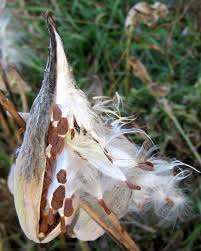OSUE Brown County Master Gardener Volunteer
Have you noticed more Milkweed plants along the roadsides? This is great news for the Monarch Butterflies and Caterpillars since the Monarchs depend on milkweeds as host plants. The butterflies deposit eggs on milkweed plants, which then provide nutrition for the caterpillar phase of the butterfly’s life cycle.
My Common milkweed, Sullivant’s milkweed, Swamp milkweed and Butterfly-weed plants have been stripped of all their leaves by the hungry Monarch caterpillars. In past years the Milkweed plants in the front yard have been the only “dining area” for Monarch caterpillars, but this year all my milkweed plants have been devoured!
Are you wondering what to do with all your milkweed pods? If you aren’t going to plant them, your county Soil and Water Conservation District office will take them. The Ohio Pollinator Habitat Initiative is calling on Ohioans for a second year of Milkweed pod collections. This project started in 2015 and since then volunteers have collected approximately 5000 gallons of Common milkweed seed pods, totaling over 22 million seeds! During September and October, everyone is encouraged to collect milkweed pods from established plants and drop them off at the nearest pod collection station. Brown County SWCD’s office is located at 706 S. Main St. in Georgetown and will serve as the collection station for Brown County. The container will be located outside the USDA Service Center at the 706 S. Main St. address.
Please make sure that before you collect seed, you become familiar with the Common milkweed plant to avoid harvesting pods from similar plants such as hemp dogbane and swamp milkweed.
To collect the seed pods from a milkweed plant, it is best to pick them when they are dry, gray, or brown in color. The pods should be mature, but not open when collected. If the center seam pops with gentle pressure, they can be picked. Try to avoid collecting the red and black milkweed beetles, since they will damage the seeds!
It is best to collect pods into paper bags. Plastic bags collect unwanted moisture. Put the date and county collected on the bag when you turn them in. Keep the pods in a cool, dry area until you can deliver them to the nearest collection site.
All milkweed pods collected during this time will be processed by the Ohio Pollinator Habitat Initiative (OPHI) partners and all of the seed collected will be used to establish new plantings and create additional habitat for the Monarch butterfly throughout Ohio.
If you have questions regarding milkweed pod collection, please contact Marci Lininger at Marci.Lininger@dot.ohio.gov or Lori Stevenson at Lori_Stevenson@fws.gov.
Do you have a Common Milkweed patch in your yard? You might want to start one and I promise that you will be glad that you did!
Interested in extending your growing season? Plan to attend our first garden seminar on Thursday, September 19, 2019 at the Mt. Orab Campus of Southern State Community College. Deb Garner, OSUE Clermont County Master Gardener Volunteer, will talk about WinterGardening. The seminar will be held in Room 208 from 7:00 p.m. to 8:00 p.m. Remember that all garden seminars are free and open to the public.

